|
||||||||||
|
|
||||||||||
|
||||||||||
|
|
||||||||||
1. Mil V-12 : 231,485 lb (105,000 kg)
The largest helicopter ever built was a massive aircraft developed in the Soviet Union during the 1960s called the Mil V-12. The V-12 was a rather unusual test vehicle that featured two rotors mounted side by side at the ends of a large wing. Each rotor had a diameter of nearly 115 ft (35 m). The helicopter was so enormous that the distance from the edge of one rotor disk to the other was almost 220 ft (67 m), even wider across than the wingspan of a Boeing 747!
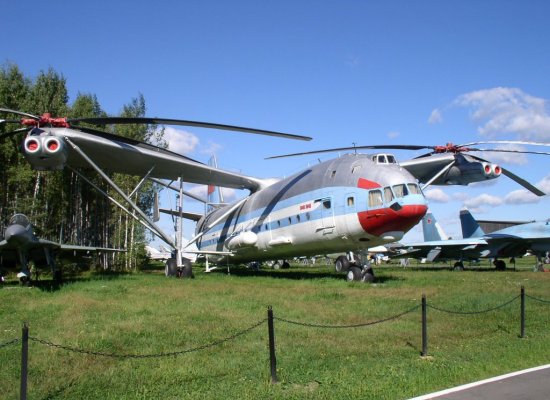
Even more remarkable was the lifting capacity of this powerful craft. The V-12 had a maximum takeoff weight of 231,485 lb (105,000 kg), nearly twice that of the second largest helicopter, and set a record in 1969 for carrying a payload of 88,635 lb (40,205 kg). So massive was the V-12 that this payload weight alone is greater than the maximum takeoff weight of the third biggest helicopter in the world! These impressive figures have earned the V-12 the record as the world's largest helicopter according to the FAI and the Guinness Book of World Records.
Only two V-12 prototypes were built, yet despite its amazing size and lifting power, the design was considered a failure by its manufacturer and Soviet authorities. The V-12 was simply too big and difficult to maneuver to be a practical machine. A production model would have been called the Mi-12, but these plans were cancelled following evaluation of the two test vehicles. One of the V-12 prototypes was retired to the Russian Air Force Museum in Monino while the second is kept at the Mil factory near Moscow.
2. Mil Mi-26 : 123,455 lb (56,000 kg)
Because the V-12 had been judged unsatisfactory, Mil was again tasked with designing a large heavy-lift helicopter for military and civil use. The resulting Mi-26 was far more compact than the V-12 due to advancements in propulsion technology, making the Mi-26 much less cumbersome to operate. With a maximum takeoff weight of 123,455 lb (56,000 kg), the Mi-26 is the world's second largest helicopter overall and the largest ever to go into production as well as the largest flying today.

Though substantially smaller than the V-12, the Mi-26 carries a considerable payload up to 44,000 lb (20,000 kg). The Mi-26 has proven much more powerful and efficient than its predecessors thanks in part to its eight-bladed main rotor. This rotor is only 106 ft (32 m) in diameter compared to the 115 ft (35 m) diameter rotors used aboard other giant Russian helicopters but can lift greater loads due to improvements in engines and blade design. Over 200 examples of the Mi-26 were built and the type remains in use throughout Russia. Several have also been sold to civilian firms and foreign nations.
3. Mil Mi-6 : 97,000 lb (44,000 kg)
The third and fourth largest helicopters are also Mil designs that helped prepare the way for the V-12 and Mi-26. The Soviet's first attempt to create an enormous heavy-lift helicopter came during the mid-1950s with the introduction of the Mi-6. Designed for many of the same duties as the improved Mi-26 some 25 years later, the Mi-6 had a maximum takeoff weight of 97,000 lb (44,000 kg) and could carry up to 24,250 lb (11,000 kg) of payload. The rotor used on the Mi-6 was the same 115 ft (35 m) diameter rotor system that would also be used on the V-12.

The Mi-6 was the world's largest helicopter when it was first built and retained the title for many years until the appearance of the V-12. The Mi-6 proved quite successful for its time as illustrated by the large number built. Some 860 were manufactured between 1960 and 1981 primarily for the Soviet Air Force and the civil airline Aeroflot. Additional models were also exported to several Soviet allies. These helicopters remained in use for over 40 years but are finally being phased out. In spite of its age, the Mi-6 still remains a remarkable vehicle and one of the largest helicopters ever conceived.
4. Mil Mi-10 : 83,775 lb (38,000 kg)
Yet another member of this related family of giant helicopters was the Mi-10. The Mi-10 was a specialized variant of the Mi-6 called a flying crane. The Mi-10 borrowed the engine and dynamic systems of the Mi-6 but these were mounted within a new fuselage. Unlike the wide Mi-6 fuselage that featured hinging doors for loading cargo internally, the Mi-10 fuselage was instead configured for passengers. This fuselage stood atop four widely spaced, extended-length landing gear legs designed to straddle large, bulky payloads carried below the helicopter.
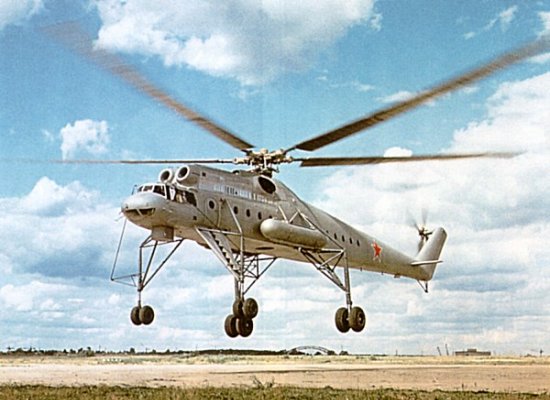
Both the Mi-6 and Mi-10 shared the same 115 ft (35 m) diameter rotor that was also used aboard the V-12. Compared to the Mi-6, however, the Mi-10 had a reduced maximum takeoff weight of 83,775 lb (38,000 kg) ranking it as the fourth largest helicopter ever built. Only about 55 Mi-10 helicopters were made and the type saw relatively little use. Both its flying crane mission and the transport duties of the Mi-6 have since been taken over by the far superior Mi-26.
5. Sikorsky CH-53E : 73,500 lb (33,340 kg)
Coming in as the fifth largest helicopter in the world is the biggest ever built in the United States, the Sikorsky CH-53E Super Stallion. The CH-53E is an enlarged model of the earlier CH-53 Sea Stallion. Both vehicles were originally developed as heavy-lift helicopters for the US Marine Corps, and they have also been used by the Navy, Air Force, and allied countries. The largest variant of the CH-53 family developed so far is the CH-53E with a maximum takeoff weight of 73,500 lb (33,340 kg). Though comparable in physical dimensions to other H-53 models with a main rotor 79 ft (24.1 m) in diameter, the CH-53E and related MH-53E are equipped with an extra engine of increased power to lift a significantly greater payload.
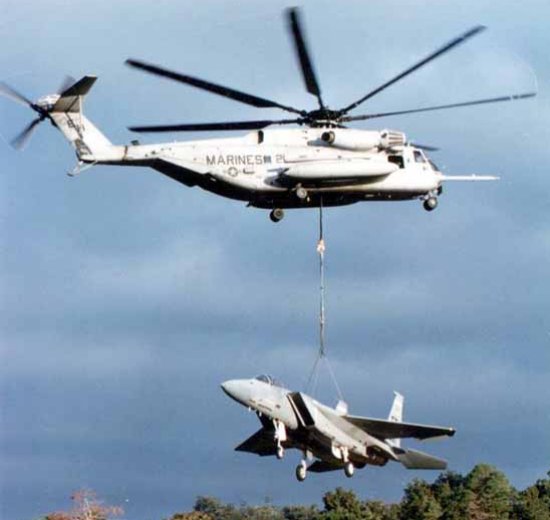
Approximately 115 examples of the CH-53E and MH-53E Sea Dragon variant were built, and these remain the largest helicopters in military service in the West. However, a new version of the venerable H-53 design is currently under development. Known as the CH-53K, this improved model will carry more powerful engines and new rotor blades to increase maximum takeoff weight to 84,700 lb (38,420 kg). Once this enhanced variant becomes available, the CH-53K should narrowly beat the Mi-10 to become the world's fourth largest helicopter.
6. Boeing Vertol MH-47E/G : 54,000 lb (24,495 kg)
The next largest helicopter is the Boeing Vertol CH-47 Chinook also developed in the United States. The H-47 family began development during the late 1950s as an enlarged variant of the CH-46 Sea Knight and has proven to be one of the most successful series of military heavy-lift helicopters. The design features a long, spacious fuselage powered by two engines driving a pair of tandem rotors 60 ft (18.3 m) in diameter. The type is widely used for transporting troops, carrying heavy military equipment like artillery slung underneath the fuselage, and resupply missions. Though the primary users are the US Army and British Royal Air Force, the CH-47 has been sold to over 20 nations as well as civilian operators.
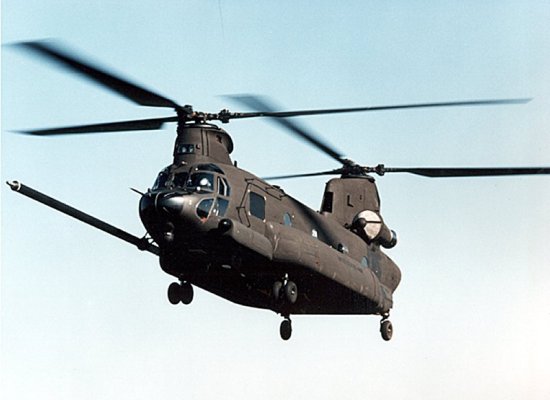
The single largest versions of the H-47 developed to date are the MH-47E and MH-47G special operations models. While most CH-47 variants have a maximum takeoff weight around 50,000 lb (22,680 kg), the MH-47E/G have been upgraded to 54,000 lb (24,495 kg). Over 1,000 Chinooks have been built to date and production of newer CH-47F, MH-47G, and HH-47 models continues today.
7. Hughes XH-17 : 50,000 lb (22,680 kg)
Coming in as the seventh largest helicopter is a unique prototype called the XH-17 Sky Crane. The Sky Crane was the first helicopter built by Hughes Aircraft, the same company that had also built the behemoth Spruce Goose flying boat during the 1940s. Shortly thereafter, Howard Hughes became interested in helicopter technology and purchased a design for a giant transport helicopter from the Kellett company. Similar to the Russian Mi-10, the Sky Crane was equipped with four long landing gear legs to straddle large oversized payloads carried underneath the fuselage. The H-17 was lifted by a massive two-blade rotor system 134 ft (40.8 m) across, still the record for the largest rotor ever flown.
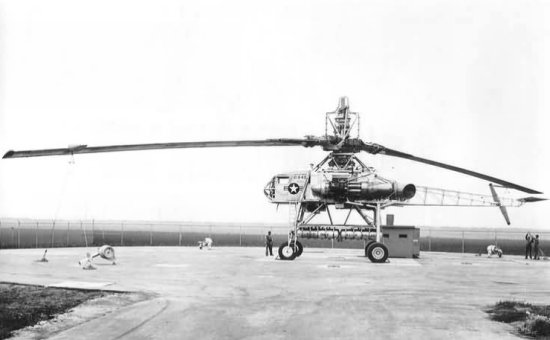
Construction of a single XH-17 prototype began during the late 1940s for use as a research vehicle. The craft was completed by 1952 when it began a three-year testing period. The maximum takeoff weight ever attempted aboard the Sky Crane was over 50,000 lb (22,680 kg) during a flight in 1953. However, the research program concluded the design was too large and cumbersome to be useful and no further models were built. Hughes also designed an enlarged variant called the H-28 that would have doubled the maximum weight to nearly 104,000 lb (47,000 kg), but further development was cancelled following experience with the XH-17.
8. Sikorsky CH-54 : 47,000 lb (21,320 kg)
Rounding out this list of large helicopters is another American design called the Sikorsky CH-54 Tarhe. Like the Mi-10 and XH-17, the CH-54 was a flying crane helicopter designed to haul large payloads slung below the fuselage. The unusual looking helicopter featured an upper spine containing the engines driving the 72 ft (21.9 m) diameter main rotor. At the front of this spine was the cockpit with windows facing both forward and aft allowing crew to monitor the payload. This minimal fuselage structure made the CH-54 a very efficient design compatible with various cargo modules that could be hoisted into position behind the cockpit for low drag.
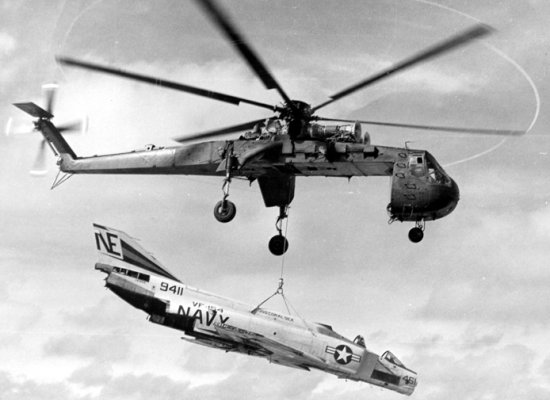
With a maximum takeoff weight of 47,000 lb (21,320 kg), the CH-54 was designed primarily for transporting military cargoes like artillery, ground vehicles, and other bulky supplies. Its lifting capabilities were frequently used during the Vietnam War to move aircraft or recover downed planes and helicopters. A civil model called the S-64 Skycrane was also developed and became popular with the logging industry and for firefighting. About 105 of these helicopters were built, and though retired from military service, several remain in civilian use.
Summary
Further illustrating just how large the helicopters described above are is the fact that no other helicopter exceeds a maximum weight of 35,000 lb (15,875 kg). The majority of helicopters are indeed quite small next to these giants since there is relatively little demand for such enormous vehicles compared to more moderately sized designs. Yet even among these giants, the size differential between them is hard to comprehend.

The above
diagram compares the Russian V-12 and Mi-26 to the American CH-53E. Despite its enormous size relative to any
other Western helicopter, the Super Stallion almost seems a toy next to the two largest helicopters ever built.
- answer by Molly Swanson, 10 December 2006
Read More Articles:


|
Aircraft | Design | Ask Us | Shop | Search |

|
|
| About Us | Contact Us | Copyright © 1997- | |||
|
|
|||